A wow-worthy customer experience (CX) that delights users throughout the entire customer journey takes a lot of careful planning.
Developing a customer experience roadmap helps you understand the experience you currently offer, learn what customers expect from you, document and share your findings, and prioritize CX improvements.
Summary
Learn how to create (and benefit from) a CX roadmap in 6 steps:
Evaluate your CX by conducting customer interviews and surveys or consulting heatmaps and session replays
Map out the customer journey to empathize with your users and identify key touchpoints to focus your CX improvement efforts on
Analyze your competitors’ CX strategies by identifying what works and what doesn’t by using their products/services, conducting social listening, and analyzing customer reviews
Ask yourself strategic questions to create a customer experience vision and make sure your CX goals align with your overall vision
After collecting and analyzing your CX data, document it in a CX roadmap by ideating, prioritizing, and visualizing CX initiatives
Finally, measure the ongoing success of your CX strategy with metrics like Net Promoter Score® or Customer Satisfaction Score
What is a CX roadmap?
A customer experience (CX) roadmap is a tactical blueprint that highlights which CX initiatives to take and when. Mapping out the experience at each touchpoint customers have with your brand lets you offer a consistent customer experience across the customer journey.
Essentially, a customer experience roadmap is your key to:
Offering a seamless customer experience
Prioritizing the most meaningful CX initiatives
Aligning your team on how to offer a customer-centric user experience (UX)
Planning your CX roadmap also helps you estimate the impact and ROI of each action you take—making it easy to get stakeholder buy-in.
Convinced you need a customer experience roadmap? Keep reading to learn how to create your own CX roadmap.
Step 1: evaluate your current customer experience
A winning customer experience roadmap is based on one principle: meeting (and exceeding) customer expectations.
To exceed customer expectations, you first have to uncover what they are, and learn where and how your current customer experience falls short.
The best bet for getting your hands on this information? Your customers.
Use the following tools to monitor customer interactions and gather data to share with stakeholders:
Customer interviews
Hop on calls with customers to ask questions about their experience with your brand and product. Find out what works and what doesn't by asking open-ended questions like:
How does our service/product fit into your daily life?
What were you doing the last time you opened our app/used our product?
What is the first thing you do after you open our app/access our product?
By letting the customer lead the conversation, customer interviews help to
Give you insight into users’ expectations as you hear directly from them
Uncover overlooked pain points in the customer experience
💡 Pro tip: in addition to talking to customers, go through the journey yourself, so you can get a taste of the experience your company offers.
“This is going to be varying degrees of possible in different types of businesses (i.e., it’s harder to do in businesses with long sales cycles), but do as much of it as you can,” suggests Benyamin Elias, Director of Growth Marketing at Podia.
“Sign up for a product or demo, make sure you’re on your company’s email lists with different segments, go through a sales process, use the product. Put in tickets to support—and if you can’t do it yourself, partner with a customer to do it and see the results. If you have customer segments with very different journeys (i.e., a developer segment/app ecosystem vs customer), go through the journey for each segment.”
All of this will help you find elements that don’t work as well as you thought they did.
Customer surveys
Launching customer surveys at various touchpoints in the customer journey helps you understand where your CX needs improvement, and what’s working well (so you can double down on it).
Ask open- and closed-ended survey questions on key pages (like a checkout page) to learn about customers' struggles in their own words, and understand how they rate specific CX aspects.
You can easily host on-site surveys—including CSAT, NPS®, and CES surveys—with Contentsquare. Use our Voice of Customer tools, like Exit-Intent Surveys and Feedback, to gather user feedback at key touchpoints along the customer journey, including landing pages, product pages, and checkout pages.
Contentsquare Heatmaps
Heatmaps are visualizations of the most popular and unpopular elements on your web and product pages. Analyze heatmaps to understand user behavior on your site, including where they get stuck and which page elements impact their experience.
Contentsquare’s Zone-Based Heatmaps are especially informative. They reveal where users click, tap, hesitate, scroll, or swipe, and what captures attention in one aggregated view. So you can easily identify which elements draw people in and what makes them leave.
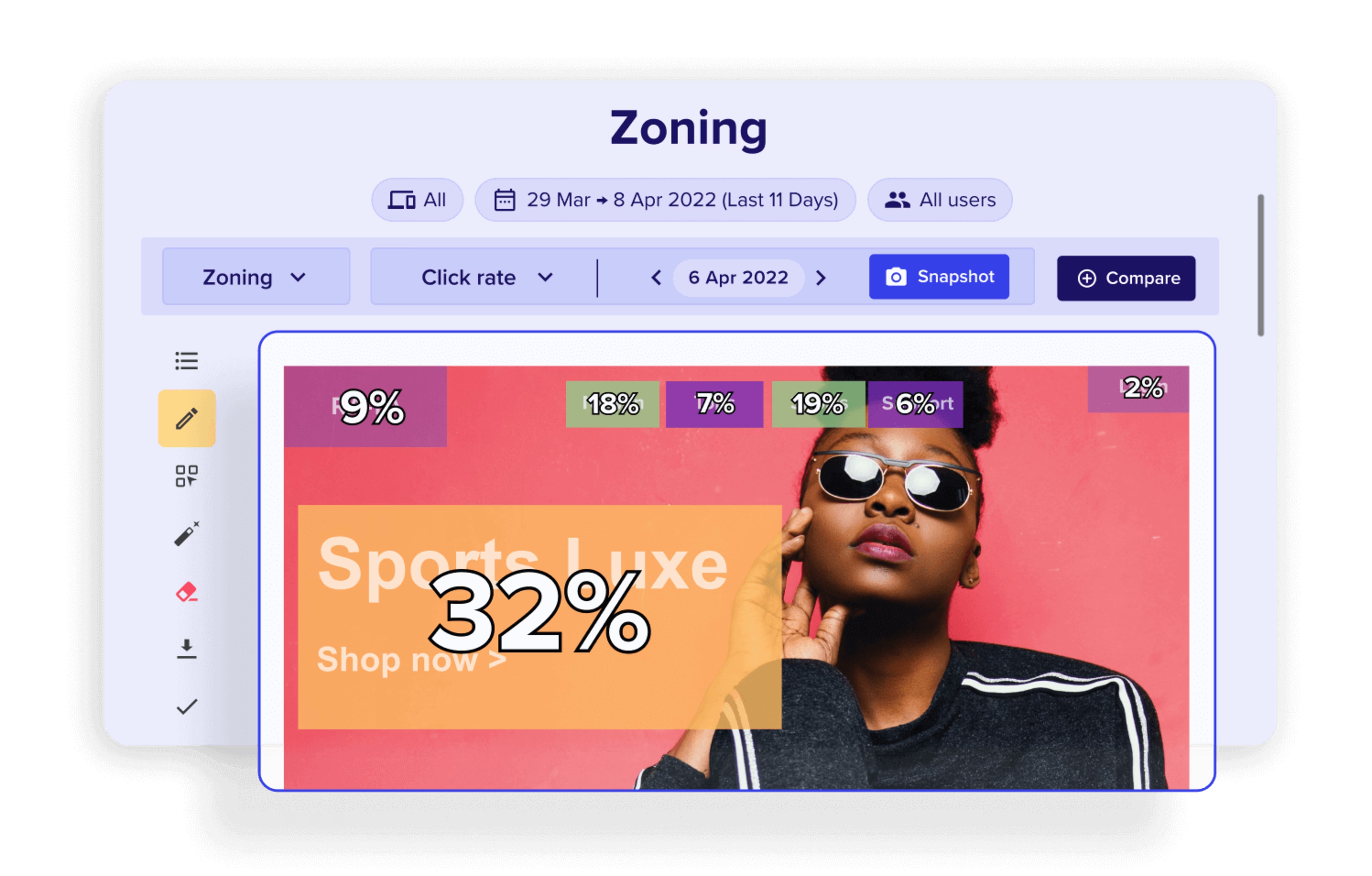
Use tools like Zone-Based Heatmaps to visualize user behavior, learn what holds customers’ attention and compels them to convert, and see which site elements are failing to engage existing users.
Contentsquare Session Replays
Session Replays (or session recordings) capture individual users’ mouse movements, keyboard strokes, clicks, and scrolls across multiple pages to give you a real-life breakdown of how customers interact with your site.
Replays also help identify opportunities to optimize the user experience. For example, you can filter Contentsquare Session Replays by rage clicks or u-turns to watch sessions where users appear to be struggling with a particular page element.
![[Visual] Session replay heatmaps](http://images.ctfassets.net/gwbpo1m641r7/7hZPhyLBOlTIk22lBfy8d3/8aa1430ae11dfb839e6f2192fd6c9c7c/Screenshot_2024-11-06_at_16.15.10.png?w=2048&q=100&fit=fill&fm=avif)
Contentsquare’s Session Replay tool gives you a first-person perspective on what users expect and can help you map the full customer journey.
Step 2: map out the customer journey
The best customer experience strategy focuses on providing an exceptional experience throughout a customer’s journey with you.
Each touchpoint plays a significant role in winning over a new customer from the moment an ideal customer discovers your product to how they interact with your sales and support team.
But you can’t deliver a strong customer experience if you don’t understand how customers interact with your business from start to finish.
Creating a customer journey map gives you a visual overview of how customers learn about your product or service, and how they interact with your brand—which helps identify which business aspects support a good customer experience, and which touchpoints need improvements.
A customer journey map also tells you how your customer feels at the end of an interaction and how and when to follow up with customers to grow the relationship further.
If you’re unsure of where to start mapping, consider using Contentsquare’s in-depth Customer Journey Analysis, which lets you experience the entire customer journey, and then portrays it with an intuitive visualization.
💡 Pro tip: evaluate each step’s relative impact on the customer experience as you study the steps users take in their customer journey.
Benyamin Elias, Director of Growth Marketing at Podia, advises you to ask yourself: “How many people hit each step? What are the conversion rates to a desirable outcome? That’s what helps you zero in on opportunities.”
Based on what you learn, you can eliminate redundant steps and refine the ones that work to improve the customer journey and offer a smooth customer experience.
Step 3: analyze competitors
Considering you likely aren’t the only solution at your customers’ disposal—and that your competitors could be offering better experiences than you (gasp!)—it’s important for your product and marketing teams to study your competitors’ CX strategies.
Not only does competitor analysis ensure you stay ahead of the curve, it also helps you learn from the competition.
As you analyze competitors' customer experiences, identify areas of improvement and areas that work exceptionally well, and apply what you learn to your own CX strategy.
For example, say it takes customers an unnecessarily long time to make a purchase from a competitor’s ecommerce site. There are too many form fields to complete, too many pop-ups and add-on offers to bypass, and by the time the customer gets to the checkout page, they’ve forgotten why they wanted the product in the first place. Use what you learn from that poor experience to offer a pleasant checkout experience of your own (and win more customers over—huzza!).
Reliable PSD Co-Founder Louisa Levit shares that studying competitors led to the birth of her business:
Before Reliable, we were customers of many of our competitors. However, we saw so many ways they fell short and left us feeling disappointed. We went point by point through each of the ways we felt let down and built Reliable to do better and deliver our dream experience. - Louisa Levit - Co-Founder, Reliable PSD
Here’s how to get to work yourself:
Become your competitor’s customer
Learn how well (or how poorly) your competitors are doing by putting yourself in their customers’ shoes.
Louisa says, “Be an avid consumer of your competitors’ products and services. Find all of the ways you’re even remotely dissatisfied with the experience, and come up with processes that would have instead left you feeling happy as can be. Just rinse and repeat for everything: their customer service, the actual product they deliver, their UI, etc.”
Take to social listening
Disappointed customers are likely to share their negative experiences online, giving you the opportunity to learn about their concerns with other brands in your industry.
Start monitoring competitors’ mentions online, and use a social listening tool—like Hootsuite or Audiense—to learn by observing how competitors interact with their customers and handle their complaints.
Analyze customer reviews
Studying competitors’ reviews on sites like G2, Capterra, and TrustRadius helps you understand the customer experience they offer by revealing how customers feel about their product or service.
To make analysis easier, use an AI-powered review analysis tool—like Talkwalker or Thematic—to quickly organize data by trends based on what customers like or dislike about a business. For example, you could sort competitors by positive reviews based on affordable prices.
Review analysis tools can also analyze customer sentiment to help you understand how competitors' customers feel about their customer experience, in their own words.
Step 4: create a customer experience vision
A vision inspires and guides any strategy, including your customer experience roadmap.
To create your CX vision, ask yourself:
What do we want to achieve with our customer experience strategy?
How will our CX delight our customers?
How will we measure the success of our CX strategy?
As you answer these questions, make sure your customer experience vision aligns with your business vision. This ensures the customer experience strategy you create delivers on your brand promise—the value you promise to always deliver to your customers.
Step 5: document your customer experience roadmap
Having gathered customer feedback and data around what’s working and what’s not, put together a cross-functional squad—including members from your marketing, product, and customer success teams—to create a customer experience roadmap based on your CX vision.
This will be your long-term action plan for which CX initiatives to prioritize. Here are three steps to develop your customer experience roadmap:
Ideate
Bring your team together to review the data you’ve gathered and brainstorm ideas for which CX initiatives to pursue. Allow everyone to write down their ideas within an agreed timeframe, then share, discuss, and vote.
Create a shareable list of winning ideas and initiatives for improving CX. With each idea you add, include the short- and long-term CX impact estimates to help you easily identify which initiatives to prioritize. For example:
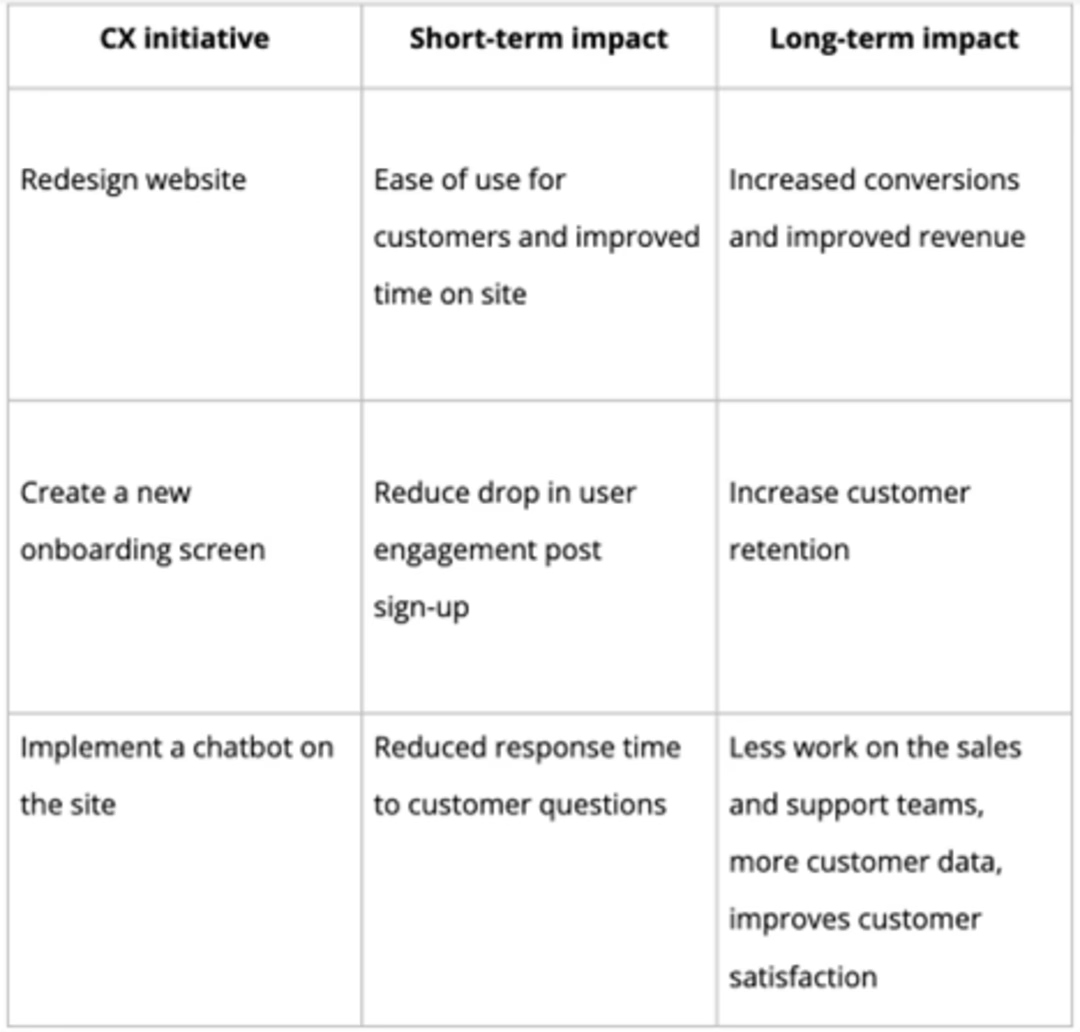
An example CX ideation list.
Prioritize steps
Once your list is ready, start prioritizing ideas in order of their importance to your customers and the impact they'll have on CX.
Based on the research and analysis you did in step 1 (evaluate the current customer experience), determine whether there's a particular issue or blocker that customers struggle with the most.
Then, use product analytics and a prioritization framework to identify which initiatives to work on first. Here are two we recommend:
Kano prioritization framework
To use the Kano Model, plot your CX initiatives on a chart with 'impact' on one axis and 'effort' on another. Prioritize the ideas that require low to moderate effort, and high impact.
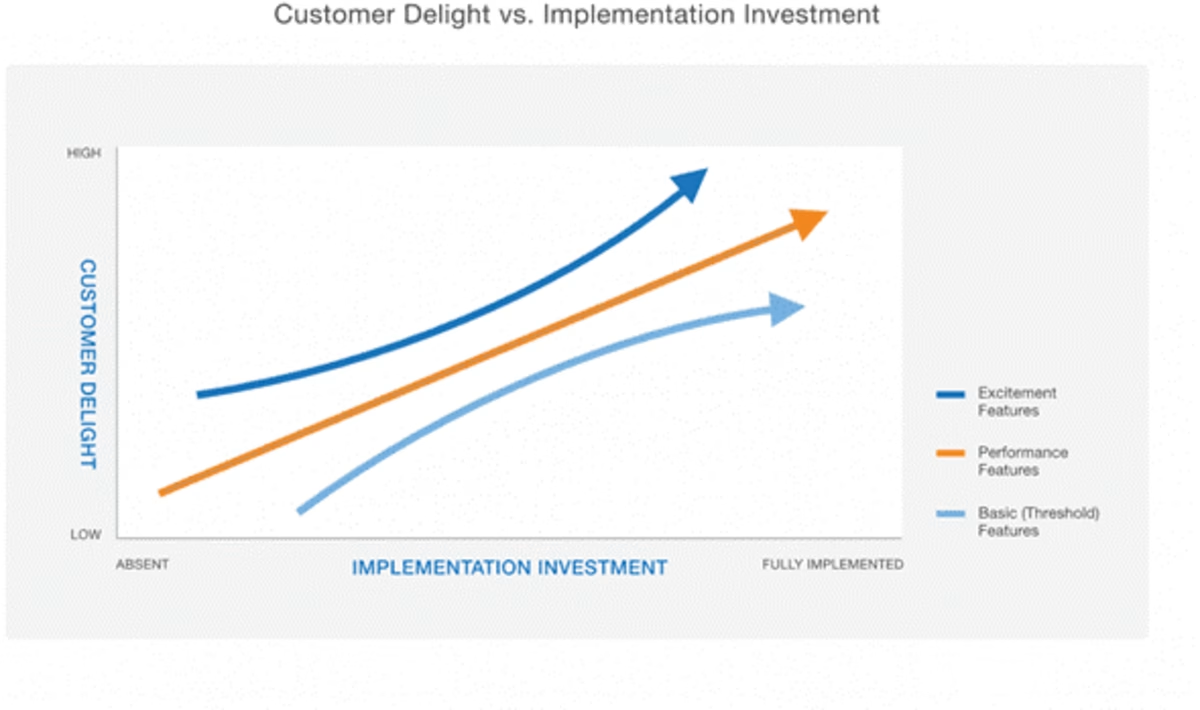
The Kano Model for prioritizing CX ideas.
RICE prioritization framework
RICE scores estimate the reach, impact, confidence, and effort for each CX initiative, giving you total scores to help you prioritize ideas:
Start by estimating the reach, or how many users will be affected in a given time
Then, estimate the impact of the initiative on customer satisfaction levels and revenue
Next, assign each idea a confidence score based on how strongly you believe in the initiative (based on data)
Finally, calculate the required effort to implement the idea
In the end, multiply R x I x C and divide by E, and prioritize the ideas with a higher score. For example:
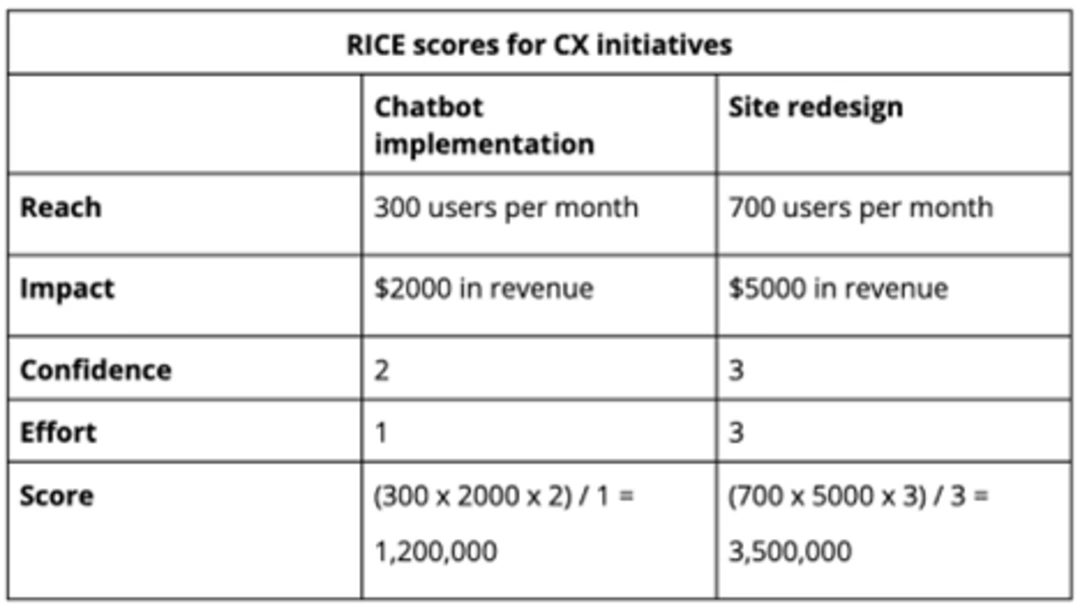
An example CX ideation list.
Whatever prioritization framework your team uses, the idea is simple: prioritize the CX initiatives that will have the most impact for your customers. This is a surefire way to satisfy existing customers—and attract new ones—which also means more revenue for your business.
💡 Pro tip: ask these three questions to guide your CX prioritization:
Which CX initiatives are the most urgent, based on where your customers struggle the most? For example, if research and usability testing show that users struggle the most with finding shipping and return details, prioritize adding those details to your homepage and product pages.
Which improvements can you implement immediately? For example, if you find your checkout button isn’t easy to tap on mobile, increasing its size can instantly make it easier for customers to shop from their phones.
What changes depend on other activities being implemented first? For instance, if optimizing call-to-action (CTA) buttons and redesigning your site are on your initiatives list, it makes sense to complete the redesign before testing new CTAs.
Visualize initiatives in a roadmap
Now that you’ve prioritized your CX initiatives, identify the following for each:
Scope of work. Think of this as breaking down each CX initiative into the tactical, actionable steps you'll need to take to complete it.
Timeline. Set realistic timelines for all the steps involved under each initiative you’ve shortlisted.
Resources needed. Decide who will be working on each step and what CX tools they’ll need to implement their work.
Then visualize it in a Gantt chart or roadmap diagram—which you can create with tools like Jira or Miro. Here’s an example:
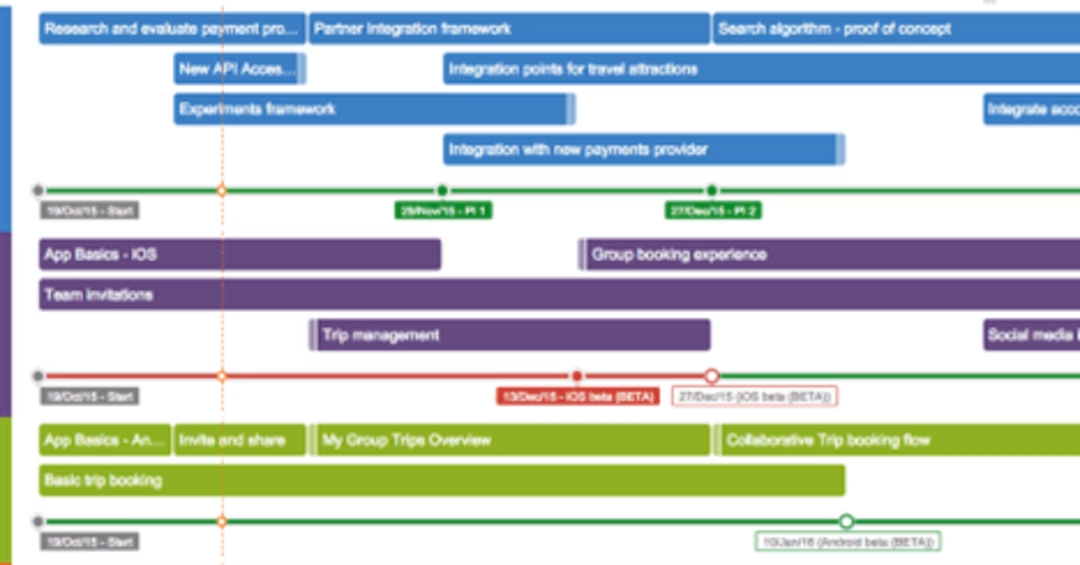
An example of a Gantt chart in Jira.
Step 6: measure the success of your CX strategy
No plan is complete without determining how you’ll track progress and results, so your last step is to select CX benchmarks and KPIs. Ask yourself:
What does success look like in three months, six months, and one year? For example, you could aim to increase customer retention by 22% in six months, and increase revenue by +15% in one year.
How and when will your team review the CX roadmap and assess the progress made? For example, your team could meet monthly to track progress on KPIs, and biannually to evaluate the roadmap’s performance (including whether it needs revising).
💡 Keep in mind: different CX initiatives will have different definitions of success—so the way you measure and analyze each CX initiative will also be different.
For example, building strong customer relationships doesn’t have a direct, quantifiable measurement. Instead, it delivers success indirectly (E.g., through increased word-of-mouth referrals and positive customer reviews).
Customer experience metrics
Three quantifiable CX metrics to measure customer experience over time include:
Customer Effort Score
Net Promoter Score®
Customer Satisfaction Score
Note: In addition to these metrics, remember to regularly review customer testimonials and ratings on review sites. As your CX improves, you’ll start seeing more positive sentiment among your customers, which can lead to improved brand reputation, increased customer retention, and more word-of-mouth referrals.
Customer Effort Score (CES)
Customer Effort Score is a measure of how easy (or difficult) it is for customers to use your product or service on a scale of 1–5 or 1–7.
As you work on CX initiatives like optimizing your site experience and support team responsiveness, ask customers feedback questions like "How easy was it to find the product you were looking for?" and "How easy was it to get your issue resolved today?" to collect CES data and understand your customers better.
Net Promoter Score® (NPS)
Net Promoter Score® surveys measure how customers feel about your brand, and are calculated by asking customers one closed-ended question about how likely they are to recommend your product or service on a scale of 1–10.
Customer Satisfaction Score (CSAT)
Calculated using CSAT surveys, this metric helps you understand how satisfied customers are about a specific CX aspect—such as your checkout process—by asking a question with a binary response like 'yes' or 'no'.
💡 Pro tip: though their results aren’t quantifiable, you can turn to qualitative CX tools like Exit-Intent Surveys.
Exit-intent surveys give users a chance to tell you why they’re leaving your site, so you can identify problem areas and prioritize optimizations based on what customers value the most. Running an exit-intent survey will help you reduce churn and keep more users engaged by eliminating factors that drive people away.
Ready to create your customer experience roadmap?
Behind every successful CX strategy is a well-thought-out customer experience roadmap. And behind every effective CX roadmap is a pool of data showing what your customers experience at each stage of their journey with you—and what they expect that experience to be.
From there, it’s about listing, prioritizing, carrying out, and tracking the CX initiatives that are most important to your customers, and continuously challenging yourself and your teams to improve the experience and create customer delight.
FAQs about CX roadmaps
Net Promoter®, NPS®, NPS Prism®, and the NPS-related emoticons are registered trademarks of Bain & Company, Inc., NICE Systems, Inc., and Fred Reichheld.

![[Visual] Contentsquare's Content Team](http://images.ctfassets.net/gwbpo1m641r7/3IVEUbRzFIoC9mf5EJ2qHY/f25ccd2131dfd63f5c63b5b92cc4ba20/Copy_of_Copy_of_BLOG-icp-8117438.jpeg?w=1920&q=100&fit=fill&fm=avif)